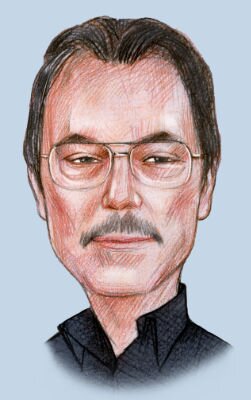
In the late 1990s, when most of us were still on dialup internet connections, you would typically get your Linux on a CD out of a book purchased for $50 — they were all $50 — from the local outlet of your big (now nonexistent) bookstore chain. When you arrived home, the book was opened, the CD removed, and the book was never opened again.
Linux was a satisfying, sometimes confusing, adventure. This was especially true of us who had used IBM’s OS/2 operating system, now that International Business Machines Corporation had betrayed us. (I suppose we shouldn’t have been surprised; the noted commentator John C. Dvorak said upon one OS/2 version’s release that it bore “the IBM stench of death.”)
But OS/2 had the best, most practically useful graphical user interface ever made. Linux at the time had no GUI to speak of. Oh, yes, there were a few cobbled-together larvae of graphical desktops, but nothing that was cohesive, let alone pretty. (You could change the appearance of various parts by editing their “.conf” files, which were written in plain text, and you’d therefore configure your desktop in a text editor.)
Things changed in 1998. That’s when version 1.0 of something called “KDE” was released. I downloaded it. Its several packages — nine, if my memory is accurate — took a while to download, even over my beloved US Robotics HST Dual Standard modem. Then you would install them in a particular order. After they were installed, one typed “startx” at a command prompt, hit enter, and the world changed.
You might suppose it would have been universally welcomed, but it wasn’t. It became the subject of heated debate. There is nothing Linux users loved more than arguing with each other. The complaint was that KDE, which was free, was insufficiently free. At the time, there was a man who was said to live in a basement at MIT. His name is Richard M. Stallman, and he was for some reason the guru of software freedom, the father of software wokeness. His complaint was that KDE was built using bits of software called Qt, its copyright held by a Finnish company called Trolltech. It therefore failed to meet Stallman’s test of purity. (Which was summed up as “free as in speech or free as in beer” and no, I don’t know what that means, either, and never have.) So his followers, who were backing a different GUI project anyway, jumped around and squawked at KDE like chickens who have seen a snake.
Yet in 1998 there was KDE and, really, nothing else. It was excellent. There were claims that soon there would be something called “Gnome” that would be even excellenter.
And some bright sunlit day there would be “Enlightenment,” the GUI to rule them all.
So it was: KDE would do until there is Gnome, and Gnome would do until there is Enlightenment. This was the state of things toward the end of 1998.
How did it turn out? Well, the people who hated KDE kept hating it, and when Gnome came out in March 1999 they pretended to love it even though it pretty much sucked. (That state of play largely remains, except that the KDE developers apparently sought to prove that their project could suck, too. They offered the proof in 2008’s arrival of KDE-4. The good part of KDE was forked and continued in development as the Trinity Desktop Environment, or TDE, which was and in my estimation still is the best desktop system for any computer in existence.)
Ah, but what of that shining desktop on the hill, Enlightenment?
In an email message on January 2, 1999, my good friend Bob Bernstein spoke of the software he would compile and try out that day. “This time my target is the current development snapshot of Enlightenment. I am getting there, having to of course run around and get stuff (much of it I'm familiar with from building Gnome) prior to tackling E itself.” There was Enlightenment but also the things you needed to be able to compile it. You would learn what these were by trying to compile it, then learn from the error message what you needed to get in order to continue. This was true of everything and we were used to it.
A few weeks later, from Bob, “He's managed to make a GUI that's harder to configure than just writing .conf files!”
The “he” Bob mentioned was a legendary figure, one of the giants before whom true computer connoisseurs could only quake in awe. He was a mystery, almost a phantom.
His name was “Rasterman.”
It still is Rasterman, “Raster” for short, though in real life he’s Carsten Haitzler. He worked at Red Hat software in that company’s early days, when it was a small company that included the likes of the famous Donnie Barnes. He left, writing at the time, “They want a windows clone distribution and OS. I do not. They don't believe users really count — corporates and ‘partners’ count and what they perceive as the ‘business world that wants an exact windows clone’ count.” Ultimately, they would get what they wanted, and Rasterman would get what he wanted, a truly superb desktop user interface.
He is a perfectionist. He was, we are told, born in Africa of German descent and lived all over the world, settling in Australia. He has a cat named “Malloc,” a term in the C programming language that means “memory allocation.” He is a coder.
And he and his hardy and talented band of associates continue work toward achieving Enlightenment. Some projects seek the quickest path, others the easiest. Raster has a vision and he’d prefer following it to just pushing something out the door.
As of today, the great writhing mass of stuff that is the current KDE is at version 6.4.3. while Gnome is at version 47. Enlightenment, which you can get and build (some Linux distributions even offer compiled versions for download, but where’s the fun in that?) is at version 0.27.
“Some might say Enlightenment deserves much more than a 0.27 version number . . . but I’m conservative. 1.0 = I'm done and happy with it and don't plan to do
any more,” he told me in an email message week before last. “It's maturity generally is far ahead of its version number.”
I have downloaded, compiled, and installed Enlightenment. It is, as has been expected these nearly three decades, gorgeous. Very pretty. There is non-intrusive, tasteful animation. There is a terminal program (“Terminology”) that is century beyond the terminal applications that other desktops provide. There are other native programs that are a delight, including “ephoto,” a very nice image viewer that does things you might have wondered why other picture viewers don’t.
Enlightenment is highly customizable — if you can figure out how to do it. It would all be frustrating if you hadn’t entered the project with the understanding that it has been and is being developed from a blank screen, not relying on how things are done but instead on how things should be done. Still, my old friend Bob, if he remained among us, would recognize that Enlightenment takes the scenic route to configuration.
Which is fine. It’s part of the fun. It is not to be rushed. And the defaults are not garish but instead gorgeous, so it’s not as if changing the original configuration were urgent.
In the mid 1990s, a German company called Star Division produced a program that combined office applications, internet, and lots of other stuff into a program that pretty much took over one’s desktop, be it on Windows, OS/2, or Linux. It was called StarOffice. It was expensive. Previous knowledge of computer use wasn’t much help in sorting it out. It was a maddening delight. (It was later freed to the community by some strange path, tamed, and it morphed into OpenOffice and now LibreOffice, though it no longer resembles what it was. There is also a current StarOffice, also not much like the original.) Enlightenment reminds me a little of the original Star Office. Sometimes the journey itself, yes, is where the satisfaction is.
The name itself, Enlightenment, takes a pretty big bite. Where did it come from?
“At the time,” he says, “everything was: twm, ctwm, fvwm, olvwm, mwm . . . always something wm [“wm” stands for “window manager”]. So . . . uninspiring. So . . . bland. So . . . meh. So I just chose a name that was . . . inspiring. That made you think ‘oooh nice.’” The native application naming follows a similar philosophy.
For all its richness, Enlightenment doesn’t require a lot of resources. I’ve been playing a lot with a 2008 ThinkPad that has limited memory, and it positively roars along. When Enlightenment began, memory was measured in megabytes, not gigabites. Intelligent use of system resources was forgotten by most everyone else.
Enlightenment, or more specifically the EFL (Enlightenment Foundation Libraries, the building blocks of Enlightenment) have figured heavily in Samsung’s development of a GUI for a multitude of connected things — telephones, television, watches. They have provided support for the project. He did a presentation a few years ago on how it all fits together. The elegance is under the hood as well, as he described in an interview.
An advantage to Linux is that you cam have multiple GUIs installed and switch among them. Here, I have both Enlightenment and TDE installed. I’m writing this in the word processor of LibreOffice running on TDE. I could just as well write it in LibreOffice, or any other Linux application, running atop Enlightenment. I’m using TDE now simply because I’m more familiar with it. Will that always be the case? Don’t know, but it’s good to have both and switch between them.
Could I switch entirely to Enlightenment? I think probably so. Might even be happier, but that satisfaction would come in some measure from the feeling that those years ago we hoped for what Enlightenment now is. Bernstein would be happy with it. It reminds us why we came here.
As Rasterman himself puts it, “I'm one of those creative types. I ALSO happen to be able to write code and do math and logic and . . . but I’m a creative arty type at heart.”

Dennis E. Powell is crackpot-at-large at Open for Business. Powell was a reporter in New York and elsewhere before moving to Ohio, where he has (mostly) recovered. You can reach him at dep@drippingwithirony.com.
You need to be logged in if you wish to comment on this article. Sign in or sign up here.
Start the Conversation